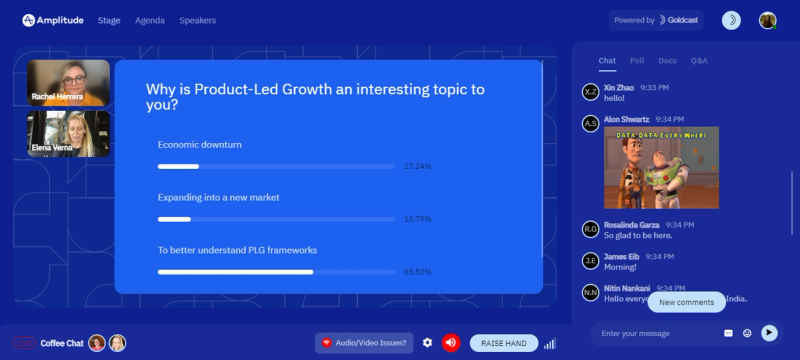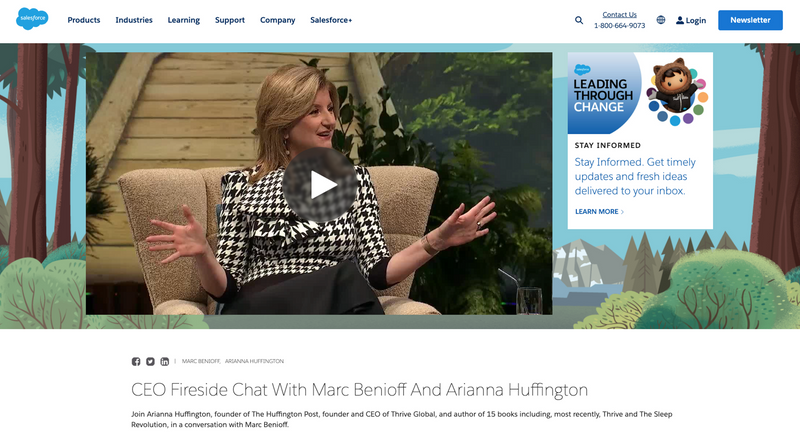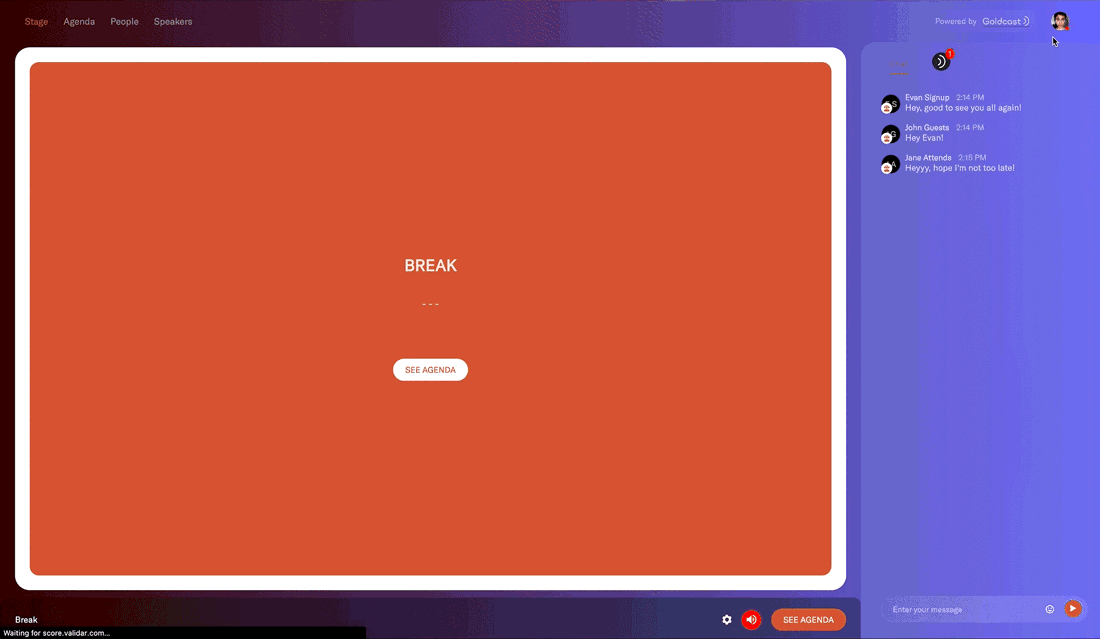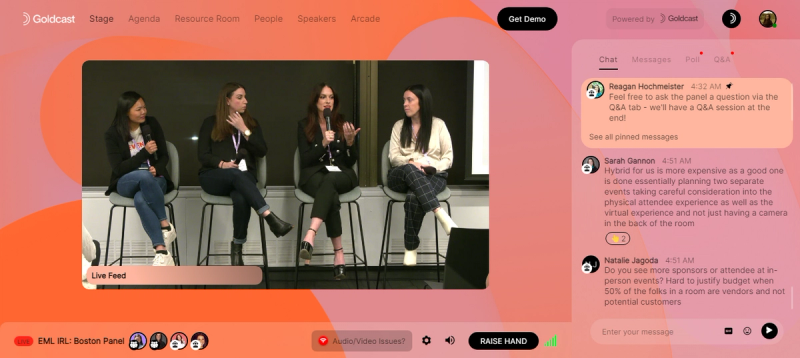Building Communities Through Events: 7 Ways to Drive Engagement and 5 Formats To Try

Maximize Your Marketing ROI
Join 10,000 other marketers already getting the best tips on running engaging events that boost pipeline and create raving fans.
One huge challenge for B2B digital marketers has been how to build a sense of community and camaraderie among virtual event attendees.
When done well, online communities allow you to connect with your target audience and provide a space for professionals of all experience levels to connect and share their stories and advice.
Read on to learn about how communities can foster global connections, as well as how to drive community event engagement and different event formats to try!
Today, we'll cover:
- Growing a loyal community webinar
- Events + communities = global connections
- 7 event tips to drive community engagement
- 5 community event formats attendees love
- For best results, be consistent—and hire a full-time community manager!
- Create an engaged, boundless community through thoughtful events
Growing a loyal community webinar
During our Rock Your Funnel series, Meisha Bochicchio, Goldcast's Senior Content Marketing Manager, spoke with:
- Jean Cameron, Global Head of Field and Channel Marketing at Productboard
- Jordan Scott, Head of Community Programs at Figma
- Jessica Langston, Senior Director, Trailblazer Community at Salesforce
So many J-names in the house!
The panel discussed their experiences with successful community events, talked about why you should be building with your community whenever possible, and talked about where to start if you're new to all this community stuff.
Check out the full session below! ⤵️
Events + communities = global connections
Many B2B organizations have built successful communities with members worldwide.
These companies use website forums or hubs, email lists, user groups, social media (Facebook, Twitter, and LinkedIn groups), and messenger app (Slack and Discord) groups to keep in touch with community members and increase engagement by initiating and moderating conversations.
Wherever you need to start, just start it and then it can grow from there." - Jean Cameron
While all of these forums have their advantages, keeping everyone engaged through walls of text can be difficult. Asynchronous communication doesn’t always work well for exchanging ideas, solving complex problems, or simply having a genuine conversation.
Also, too often, keeping a community restricted to these mediums can lead to the community becomingjust another content distribution channelfor the company.
That’s where events come in. Think about it: It’s one thing to listen to your favorite band on streaming apps. But watching them belt out your favorite tunes live is a different adrenaline rush! Whether in-person, virtual, or hybrid, events work similarly for branded communities.
Communities like Women In Sales,Exit Five, Modern Sales Pros, MoPros, and more trust Goldcast to organize their B2B events and bridge the gap between online communities and real-time interactions. These events connect members personally, facilitate idea-sharing and problem-solving, and build trust along the way.
7 event tips to drive community engagement
Before we get into actionable tips, it's worth acknowledging the concept of building with your customers. During our webinar discussion, we talked about how there's a subtle difference between building for your audience vs with them.
If you can start small at the beginning and involve your customer every step of the way, you stand a much better chance of growing alongside them in a meaningful way.
Alright! Now that you know why communities and events make a kickass combo, you might be wondering how to make these events engaging as a community manager. Here are seven suggestions from our own event marketing team!
1. Use the live chat as an icebreaker
Dropping your icebreaker in the live chat ensures people don’t have to go out of their way to engage, which is important when they’re just logging on. You want to keep things easy!
As attendees log in, the mod team can post icebreaker prompts. Here are a few ideas:
- Describe your mood using an emoji 🥳
- Tell us where you’re joining from!
- What are you hoping to learn from today’s event?
If you’d like to spark ongoing connections, you can also invite attendees to share their LinkedIn profiles in the chat section. This is a surefire way to foster a sense of community and keep conversations going long after your event is over.
2. Try polls to gauge audience sentiments
Like live chat, polls require little effort on the audience’s part and allow you to quickly read the room. If you want to know whether attendees are interested in something, offer a simple yes/no poll—or try multiple choice if you want to present them with a breakdown of different answers.
For example, you could ask people how many years they’ve been using a certain product and then display the results, so the audience has an idea of where everyone is coming from.

Polls also help you understand your attendees during post-event analysis.
Here are a few examples of polls you can experiment with:
- Regarding <topic>, what’s the biggest challenge you are facing right now? → Provide multiple choices; you can also survey customers or attendees beforehand to get an idea of common answers
- On a scale of 1-5, how insightful was the previous session? → See how well your content resonated
- What’s your job title? → This can help you better understand who’s in the audience
- How did you hear about the event? → This will help you understand the effectiveness of marketing channels
- What are you hoping to gain from today’s event? → Provide multiple choices related to top takeaways or outcomes to prime the audience
Experiment with ways to sprinkle in poll questions throughout your event to keep engagement high and make things interactive. You might even try a quick trivia game or a fun quiz!
3. Encourage attendees to participate in the Q&A
Community events are meant to be interactive, which is why Q&A sessions make total sense.
Instead of remaining passive listeners, Q&A sessions allow community members to be first-hand participants in the discussion. Instead of the typical text format, try video Q&A to add more of a human element.

Video Q&A works just like inviting an audience member onto the stage so they can interact with the speaker or panel. This helps not only to have meaningful conversations but also ensures that nuance isn’t lost, which can be challenging over text.
4. Foster connections with breakout sessions and rooms
You can’t beat the power of 1:1 or 1:few connections, and community events offer a natural place to build and foster relationships. But even things like video Q&A can only go so far in putting faces to names and breaking down the digital barriers.
Breakout sessions and networking rooms are the best ways to bring folks together. But what’s the difference?
A breakout room happens when the organizer pushes event attendees into a private session together. These can either be randomized or pre-assigned. This type of experience is handy for working sessions where you want folks to work together or discuss a topic and then head back into the main event.

Rooms offer a more passive experience where attendees can pop in at their leisure before, during, or after an event. These work well as networking rooms with a pre-assigned topic.
It can be something educational, like “what was your favorite part of today’s event” or something totally fun, like “what shows are you watching right now?” Just remember to assign a moderator to keep the conversation flowing.
How can you mix things up and make it feel new, exciting, and engaging?" - Jordan Scott
Jordan mentioned trying both Braindate and Remo to offer attendees new, exciting ways to connect. Braindate creates a networking marketplace for topics, where people can choose what they want to talk about, and Remo is a VR-like event in which people watch a virtual keynote and choose a table to sit at, where they'll mingle with others. Using tools like this in targeted ways allows people to opt in to intentional networking opportunities.
5. Drive engagement through experiential sessions
Information overload is real, and we all know people are glued to their screens for hours a day.
To offset potential Zoom fatigue, introduce fun elements to your event. Incorporate live experiences like music, standup comedy, magic shows, or mentalists to let attendees cool off and “zone out” from consuming content for a bit.

Photo booths are also a fun idea. You can custom design a background for your event, create cool filters or lenses, and let attendees take photos and share them during event breaks!

6. Gamify engagement
Games are fun for a reason; they reward favorable behaviors and incentivize people to keep going.
There are two ways you can gamify your event to increase engagement:
- The first is active participation, where you incentivize certain behaviors (for example, participating in chat, polls, or Q&A) through points or badges. Getting featured on a leaderboard like Top Contributors is a great motivator for attendees to speak up!
- The second is passive participation, which is helpful to stave off Zoom burnout. Basically, you integrate platforms like Drimify and Engamio with Goldcast to introduce customizable games. Whenever attendees get bored, they can play games while still being passively involved in the event. You prevent drop-offs and increase engagement. Win-win!
One caveat: While gamification works great to boost engagement, use it sparingly. It should be the salt-and-pepper of your event and not the meat-and-potatoes! The value of the community—and, by extension, the event—should always be the major incentives.
Janessa Lantz, VP of Marketing at dbt Labs, sums this up nicely. “The real value comes through relationships established with other people,” she explains. “So, if you’re creating spaces where like-minded folks can connect and learn from each other, that should be incentive enough.”
7. Deliver quality follow-up resources
It’s difficult to cover all your bases in just one session, which is when follow-up resources come in handy. Providing quality information after your talk helps attendees know where to start as they look for more information.
You can also include the same content and resources in the Docs tab so attendees can download and review after the event.
As marketers, we like big numbers. We like long subscriber lists, lots of attendees and engagement, views, etc. But community is not about the relationship of the company to the audience. Instead, it’s about member-to-member connections.” - Janessa Lantz, VP of Marketing at dbt Labs
5 community event formats attendees love
Now that you know ways to up the engagement and community feel of your event, what type of formats work well? Here are five formats we’ve seen companies use and how they work.
1. Fireside chats
A fireside chat is an informal conversation between a moderator and a guest. The guest speaker is typically an industry leader or a subject matter expert, making fireside chats a perfect fit for thought leadership discussions.
Fireside chats feel like you’re being let into someone’s living room to listen in on an insightful conversation between two people. The conversation usually begins on a personal note, and the guest may share how they got their start in the industry. From there, things flow into work and related topics.
At the end of the chat, audience members may be invited to ask the guest questions during a Q&A.
A great example of fireside chats is Dreamforce’s CEO Fireside Chat. This event features Marc Benioff (CEO of Salesforce) as the interviewer and eminent industry folks as guests. The event has hosted industry leaders like Arianna Huffington of The Huffington Post and Thrive Global, Satya Nadella of Microsoft, and Marco Bizzarri of Gucci.

2. Educational webinars
Educational webinars are what you’d refer to as traditional webinars. Often organized as monthly sessions, these events feature informational or educational topics to help community members up their professional game.
Many times, educational webinars also host a community member as the presenter.
For example, Product Marketing Alliance (PMA) is a community hosting product marketers, ranging from new enthusiasts to pros. PMA’s educational webinars feature different people discussing product marketing-related topics.
Or take SparkToro’s Office Hours, when CEO Rand Fishkin and Amanda Natividad, the VP of Marketing, discuss marketing.

3. Coffee chats
A key benefit of communities is the ability to network with like-minded people. However, one limitation of webinars is that you can’t really “hang out” with people like you might in person.
Enter: coffee chats.
Basically, a coffee chat is a session where community members come together and chat, just like they would during a coffee break at a conference. Coffee chats can be 1:1 or 1:many, as with breakout rooms.
There are absolutely no set rules when it comes to planning coffee chats. You can have a roundtable or debate session where you nerd out over your favorite topics, or you can simply network with fellow members to identify potential partnerships or collabs.

4. Virtual summit
Virtual summits deliver a full-fledged conference experience, which can run between half a day to multiple days.
These events are usually comprised of different session formats, such as presentations, panel discussions, fireside chats, and lively networking sessions.
Virtual summits can also be multi-track and allow attendees to mix and match their favorite sessions and create their own agendas.
SparkToro’s SparkTogether 2022 is one example of a day-long virtual summit featuring marketing experts. Throughout promotions for the conference, the company upped the exclusivity factor by not recording any of the content and asking attendees to stay off social media during the event.
5. Hybrid community events
With in-person events regaining their footing, community events are back—with a twist. They’ve now mostly evolved to allow people to join virtually if they choose.
Compared to virtual events, hybrid events are a bit complicated to manage. There are a lot of moving parts: staffing, content, venue, logistics, etc. That’s very different from your standard virtual event!
However, the advantage of hybrid events is that you can reap the benefits of both physical and virtual events, all in one. It’s definitely worth a shot!
We’ve hosted a few hybrid community events here at Goldcast with our Event Marketers Live “In Real Life” roadshow. These events include an intimate in-person gathering and a panel interview that’s live-streamed to our remote audience. Through the magic of Goldcast, our in-person and virtual attendees can interact and engage together.

BTW: Here’s a nifty resource to help you understand how to budget your next hybrid event, complete with a free template!
For best results, be consistent—and hire a full-time community manager!
In order to create an engaged community, you'll need to keep up some sort of regular event cadence.
For big, established organizations like Salesforce, this looks like 300-400 user group meetings per month—a huuuuuge number, but one that makes sense given the scope of their community! For a smaller organization, the frequency might be much, much lower. Think: 1-2 meetings a quarter!
The community really drives the decisions, and we're there to support them." - Jessica Langston
The bottom line: It's important that people know that there will be a regular meeting place they can go. Make sure your audience is aware of upcoming events and how often they happen. Here at Goldcast, we're starting out with quarterly community events, and we'll continue to reassess as we scale!
Final note: One thing that everyone we spoke to agreed on is that building a community is a full-time job. Many times, people think it can be done "on the side" in addition to other marketing tasks, but it takes dedicated focus to truly scale a community. To see big results, you'll want to have someone who's living and breathing community as a goal!
Create an engaged, boundless community through thoughtful events
As a community manager, your job is to engage people, foster conversations, and provide value.
Consistently organizing events allows you to bring people together, share knowledge, build connections, and learn what people are looking for.
And be patient! As Jordan put it, "Community happens in small moments over long periods of time." We're playing the long game here!

Transform Your Video Marketing with AI
Stay In Touch
Platform
Resources
© 2025 Copyright Goldcast, Inc. All rights reserved.





 Upcoming Events
Upcoming Events Event Series
Event Series On-Demand Events
On-Demand Events

